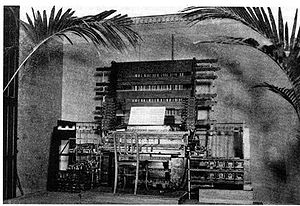
In 1906, Spotify Looked Like This: The Teleharmonium
“Wait,” you’re thinking, “There wasn’t an Internet in 1906, was there?” Well, no. But people were working on sharing music even though the recording industry was barely a decade old.
Tom points us to the Teleharmonium, a pretty cool electromechanical device that allowed people to stream music their phones. It was, however, a bit…bulky.
Atlas Obscura picks up the story.
Invented by lawyer Thaddeus Cahill and initially known as the dynamophone, the telharmonium made use of telephone networks to transmit music from a central hub in midtown Manhattan to restaurants, hotels, and homes around the city. Subscribers could pick up their phone, ask the operator to connect them to the telharmonium, and the wires of their phone line would be linked with the wires emerging from the telharmonium station. The electrically generated tunes would then stream from their phone receiver, which was fitted with a large paper funnel to help pump up the volume. (The electric amplifier had not yet been invented.)
The music was generated live at what Cahill called a “music plant,” which was located at Broadway and 39th Street. An entire floor of the building, which came to be known as Telharmonic Hall, was filled with the 200 tons of machinery required to generate the telharmonium’s tunes. With its banks of spinning rotors, switchboards, transformers, and alternators, the behemoth instrument gave “the impression of nothing so much as a busy machine-shop, or the center of a considerable manufacturing industry,” according to a 1906 article in McClure’s Magazine.
It’s fascinating steam-punk sort of stuff. Keep reading.




Pingback: In electro-spect… | Electrical Apparatus Magazine